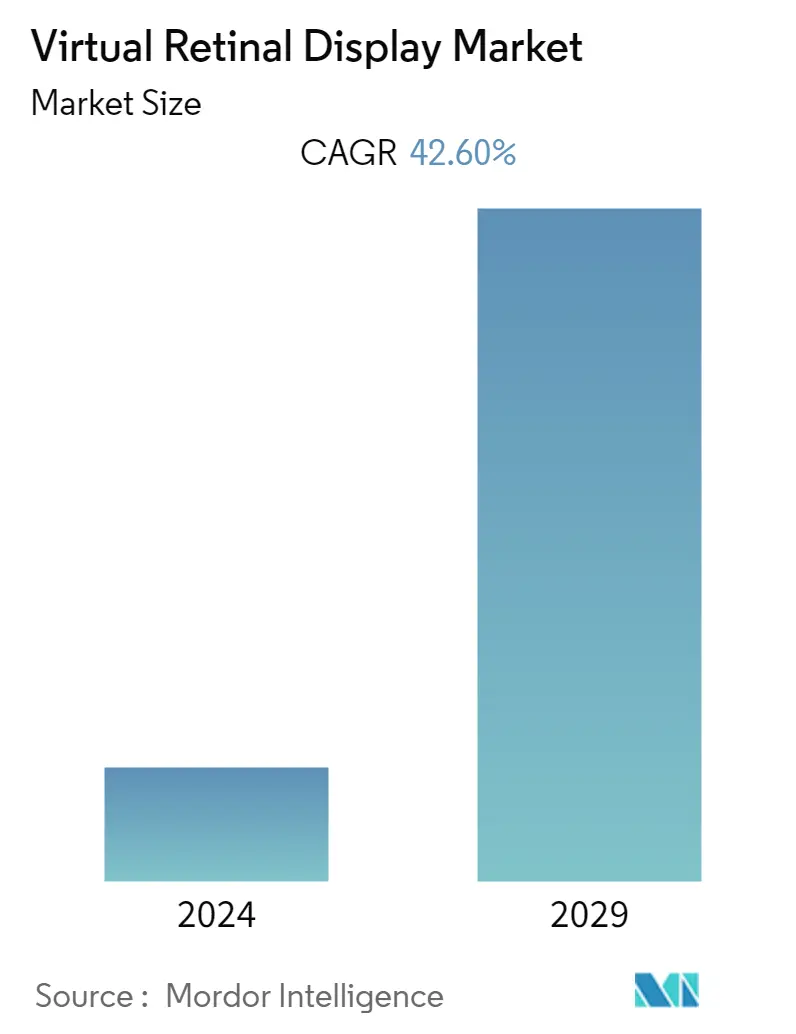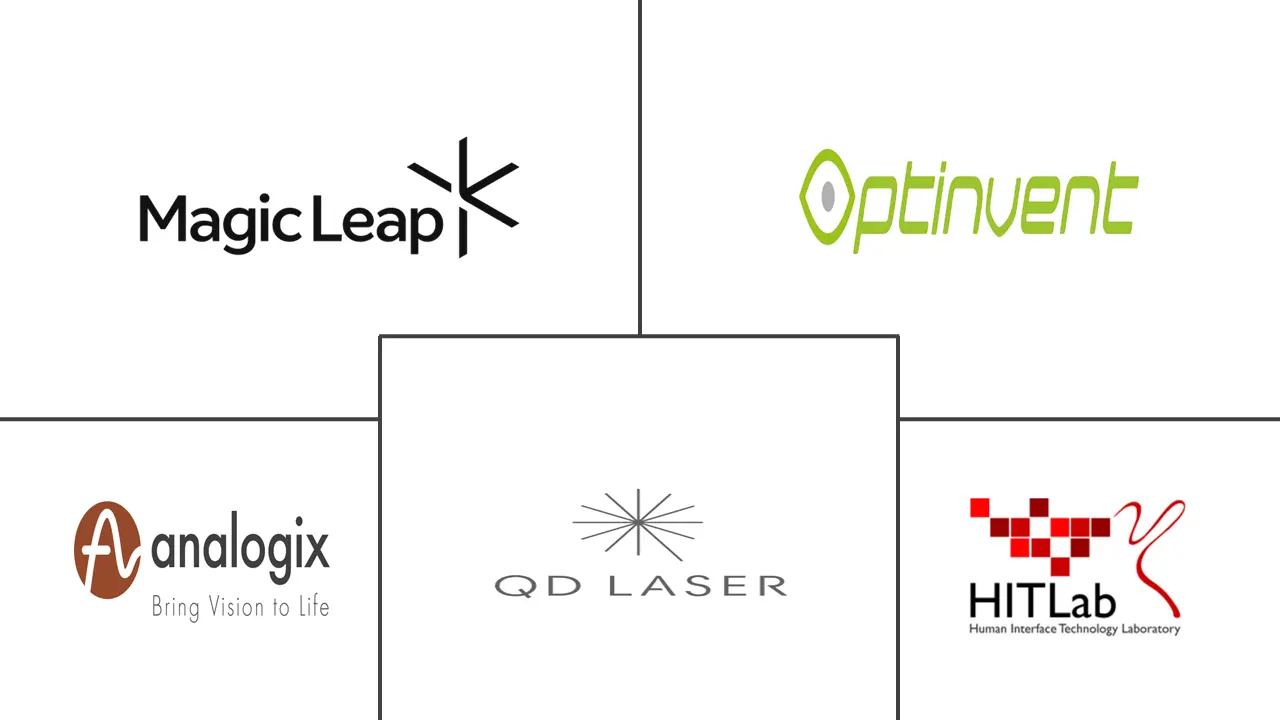Market Size of Virtual Retinal Display Industry

| Study Period | 2019 - 2029 |
| Base Year For Estimation | 2023 |
| CAGR | 42.60 % |
| Fastest Growing Market | North America |
| Largest Market | North America |
| Market Concentration | Low |
Major Players
*Disclaimer: Major Players sorted in no particular order |
Virtual Retinal Display Market Analysis
The Virtual Retinal Display Market is expected to register a CAGR of 42.6% during the forecast period. In the screenless display market, direct retinal technology is estimated to be the fastest growing, compared to the visual image and Synaptic Interface technology. Virtual Retinal Display (VRD) was developed to solve the limitations of image quality, weight, and cost problems associated with head-mounted display technology. Providing a wider field of view, this technology also addresses the technical limitations that Mixed Reality technology faces.
- The retina display is highly secure and safe compared to other displays. Using a retina display, the user can control the intensity of the display through his voice. The adoption of this technology is making people easy to work in any environment without any security or privacy issues.
- As the technology addresses the high eye strain caused by night vision goggles, the technology finds applications in the aerospace and defense sector. The applications are widespread in the healthcare sector and range from treating trauma to being used as an aid in cancer detection.
- The virtual retinal display is highly efficient concerning power consumption, requiring far less power than the postage-stamp LCD screens used commonly in today's mobile devices. The gaming & entertainment industry application is driving the demand for the virtual retinal display market because this industry has been an early adopter of the technology and the demand created for augmented reality and virtual reality applications by users.
- On the other hand, the need for more awareness about the virtual retinal display is expected to hamper the market's growth. The major problem with virtual retinal displays is they can cause motion sickness. These restraining factors are said to decline the market's growth.
- The COVID-19 pandemic is influencing society and the global economy. The closure of manufacturing facilities globally has resulted in a significant loss of revenue and business for the nations under lockdown. The pandemic has had a significant negative impact on the production and manufacturing processes. However, to fight COVID-19, companies have been actively investing in product development.
Virtual Retinal Display Industry Segmentation
A virtual retinal display (VRD) utilizes photon generation and manipulation to create a high-resolution, panoramic, color virtual image projected directly onto the human eye's retina without making a real or an aerial image viewed via a mirror or optics.
The Virtual Retinal Display Market is segmented by End-user Industry (Medical and Life sciences, Aerospace and Defense, Media and Entertainment) and Geography. The market sizes and forecasts are provided in terms of value (USD million) for all the above segments.
| By End-user Industry | |
| Medical & Lifesciences | |
| Aerospace and Defense | |
| Media and Entertainment | |
| Other End-user Verticals |
| By Geography | |
| North America | |
| Europe | |
| Asia-Pacific | |
| Latin America | |
| Middle East & Africa |
Virtual Retinal Display Market Size Summary
The Virtual Retinal Display (VRD) market is poised for significant growth, driven by its innovative technology that overcomes the limitations of traditional head-mounted displays, such as image quality, weight, and cost. This technology offers a broader field of view and addresses challenges faced by Mixed Reality technologies, making it highly appealing for various applications. The VRD is particularly valued for its security features, voice-controlled intensity, and low power consumption, which are advantageous in sectors like aerospace, defense, and healthcare. The gaming and entertainment industries are early adopters, leveraging VRD for augmented and virtual reality applications, which are increasingly in demand for immersive experiences. However, the market faces challenges such as limited awareness and potential motion sickness issues, which could hinder growth.
The North American region, especially the United States, leads the VRD market due to early adoption and growing demand for augmented and virtual reality solutions. The technology's benefits, such as lightweight design, high resolution, and sufficient contrast, are attracting investments from startups and established companies alike, aiming to enhance research, development, and commercialization efforts. The defense sector's increasing investments further bolster market demand, as VRD technology is utilized for advanced military applications. The competitive landscape is marked by numerous vendors offering diverse solutions, with key players like Avegant Corporation and Magic Leap Inc. actively expanding their product offerings. Collaborations and technological advancements, such as those by TDK Corporation and Microsoft, are driving innovation, particularly in smart glasses and specialized augmented reality applications for industries like healthcare and manufacturing.
Virtual Retinal Display Market Size - Table of Contents
-
1. MARKET INSIGHTS
-
1.1 Market Overview
-
1.2 Industry Attractiveness - Porter Five Forces
-
1.2.1 Bargaining Power of Suppliers
-
1.2.2 Bargaining Power of Consumers
-
1.2.3 Threat of New Entrants
-
1.2.4 Threat of Substitutes
-
1.2.5 Intensity of Competitive Rivalry
-
-
1.3 Impact of COVID-19 on the Virtual Retinal Display Market
-
-
2. MARKET SEGMENTATION
-
2.1 By End-user Industry
-
2.1.1 Medical & Lifesciences
-
2.1.2 Aerospace and Defense
-
2.1.3 Media and Entertainment
-
2.1.4 Other End-user Verticals
-
-
2.2 By Geography
-
2.2.1 North America
-
2.2.2 Europe
-
2.2.3 Asia-Pacific
-
2.2.4 Latin America
-
2.2.5 Middle East & Africa
-
-
Virtual Retinal Display Market Size FAQs
What is the current Virtual Retinal Display Market size?
The Virtual Retinal Display Market is projected to register a CAGR of 42.60% during the forecast period (2024-2029)
Who are the key players in Virtual Retinal Display Market?
Magic Leap Inc., Optivent, Analogix Semiconductor Inc., QD Laser Co. Ltd and Human Interface Technology Laboratory are the major companies operating in the Virtual Retinal Display Market.

